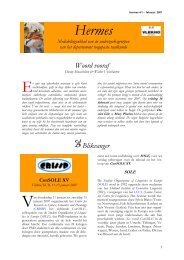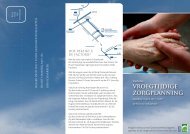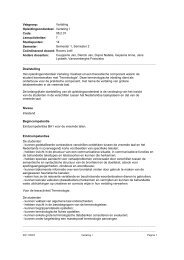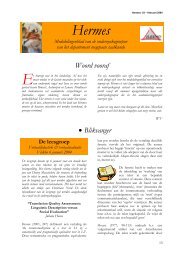HUB RESEARCH PAPER - Hogeschool-Universiteit Brussel
HUB RESEARCH PAPER - Hogeschool-Universiteit Brussel
HUB RESEARCH PAPER - Hogeschool-Universiteit Brussel
Create successful ePaper yourself
Turn your PDF publications into a flip-book with our unique Google optimized e-Paper software.
Process consultation revisited 25<br />
This experience contrasts with the change process in the consulting organization. Here<br />
also a two-day long ‘strategy-meeting’ is organized that was facilitated by an external consultant<br />
in order to create a common vision and strategy for the company. The action principles of<br />
appreciative inquiry (e.g., Cooperrider, Withney & Stavros, 2003) were similarly used. At this<br />
meeting participants also enacted energizing and reciprocal practices. This resulted in setting up<br />
three task forces that were mandated to elaborate on important strategic issues identified. All<br />
participants agreed to organize a follow-up session six months later. However, the quality of<br />
interacting during the task force meetings was characterised by monologic talk, dominance of<br />
certain ‘voices’ and often lack of engagement. As a result every task force faded out. In the<br />
follow-up meeting six months later only half of the actors who participated at the strategy<br />
meeting were present. Interactions were characterized by low energy, ‘aboutness’-talk, no<br />
possibility for mutually testing assumptions and by a problem-oriented self-reinforcing discourse<br />
that made actors get stuck in mere analysing without progression. Eventually a steering<br />
committee was established and the decision was made to monthly meet with the whole<br />
organization. In the continuation of the change process, the original goal, creating together a<br />
vision and strategy, and acting on it, is put on the agenda several times, but no real progress has<br />
ever been made. The pattern here is that change initiatives remain isolated without qualitative<br />
coupling. Several relational practices are set up but fade quickly without a sustainable<br />
connection to other change activities.<br />
By looking through a ‘relational practice’ lens, one can see that organizational change<br />
generally implies that a diversity of actors bring about a variety of change initiatives at various<br />
places in the organization (e.g., reformulating the company’s vision, creating new tasks and<br />
functions, generating new structural arrangements, setting up new training activities, etc.). All







